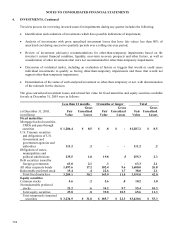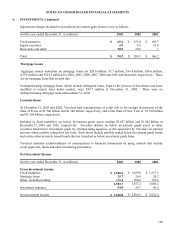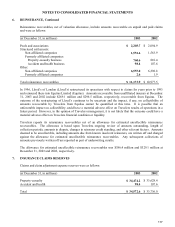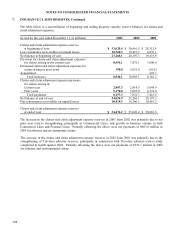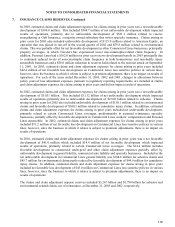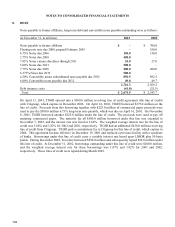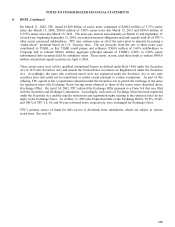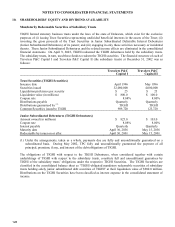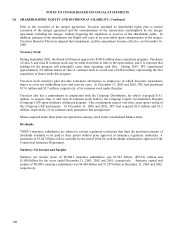Travelers 2003 Annual Report Download - page 122
Download and view the complete annual report
Please find page 122 of the 2003 Travelers annual report below. You can navigate through the pages in the report by either clicking on the pages listed below, or by using the keyword search tool below to find specific information within the annual report.120
NOTES TO CONSOLIDATED FINANCIAL STATEMENTS
7. INSURANCE CLAIMS RESERVES, Continued
It is difficult to estimate the reserves for asbestos and environmental-related claims due to the vagaries of court
coverage decisions, plaintiffs’ expanded theories of liability, the risks inherent in major litigation and other
uncertainties, including without limitation, those which are set forth below.
Because each policyholder presents different liability and coverage issues, Travelers generally evaluates the
exposure presented by each policyholder on a policyholder-by-policyholder basis. In the course of this
evaluation, Travelers considers: available insurance coverage, including the role of any umbrella or excess
insurance Travelers has issued to the policyholder; limits and deductibles; an analysis of each policyholder’s
potential liability; the jurisdictions involved; past and anticipated future claim activity and loss development on
pending claims; past settlement values of similar claims; allocated claim adjustment expense; potential role of
other insurance; the role, if any, of non-asbestos claims or potential non-asbestos claims in any resolution
process; and applicable coverage defenses or determinations, if any, including the determination as to whether or
not an asbestos claim is a products/completed operation claim subject to an aggregate limit and the available
coverage, if any, for that claim. When the gross ultimate exposure for indemnity and related claim adjustment
expense is determined for a policyholder, Travelers calculates, by each policy year, a ceded reinsurance
projection based on any applicable facultative and treaty reinsurance, as well as past ceded experience.
Adjustments to the ceded projections also occur due to actual ceded claim experience and reinsurance
collections. Conventional actuarial methods are not utilized to establish asbestos reserves. Travelers evaluations
have not resulted in any data from which a meaningful average asbestos defense or indemnity payment may be
determined.
With respect to asbestos exposures, Travelers also compares its historical direct and net loss and expense paid
experience, year-by-year, to assess any emerging trends, fluctuations or characteristics suggested by the
aggregate paid activity. As anticipated, losses paid have increased in 2003 compared to prior years. There has
been acceleration in the amount of payments, including those from prior settlements of coverage disputes entered
into between Travelers and certain of its policyholders. For the years ended December 31, 2003 and 2002,
approximately 57% and 54%, respectively, of total paid losses relate to policyholders with whom Travelers
previously entered into settlement agreements that limit Travelers liability. Net asbestos paid losses were $451.8
million and $361.1 million for the years ended December 31, 2003 and 2002, respectively, reflective of the items
previously described.
At December 31, 2003, asbestos reserves, net of reinsurance, were $2.977 billion, a decrease of $427.6 million
compared to $3.404 billion as of December 31, 2002. The decrease is reflective of the $451.8 million of
payments made during the course of 2003, partly offset by accretion of discounts of $24.2 million on reserves for
certain policyholders with structured agreements. Other than accretion of discounts, there were no additions to
asbestos reserves in 2003 compared to an addition of $2.945 billion in 2002.
At December 31, 2002, asbestos reserves were $3.404 billion compared to $820.4 million as of December 31,
2001. Net incurred losses and loss adjustment expenses were $2.945 billion for 2002 compared to $188.8
million for 2001. The increase in reserves was based on Travelers analysis of asbestos claims and litigation
trends. As part of a periodic, ground-up study of asbestos reserves, Travelers studied the implications of these
and other significant developments, with special attention to major asbestos defendants and non-products claims
alleging that Travelers coverage obligations are not subject to aggregate limits. In addition, Travelers
management expanded its historical methodology in response to recent trends. This included further
categorization of policyholders, conducting a detailed examination of recent claim activity from policyholders
reporting claims for the first time, and conducting a detailed review of past settlements.




